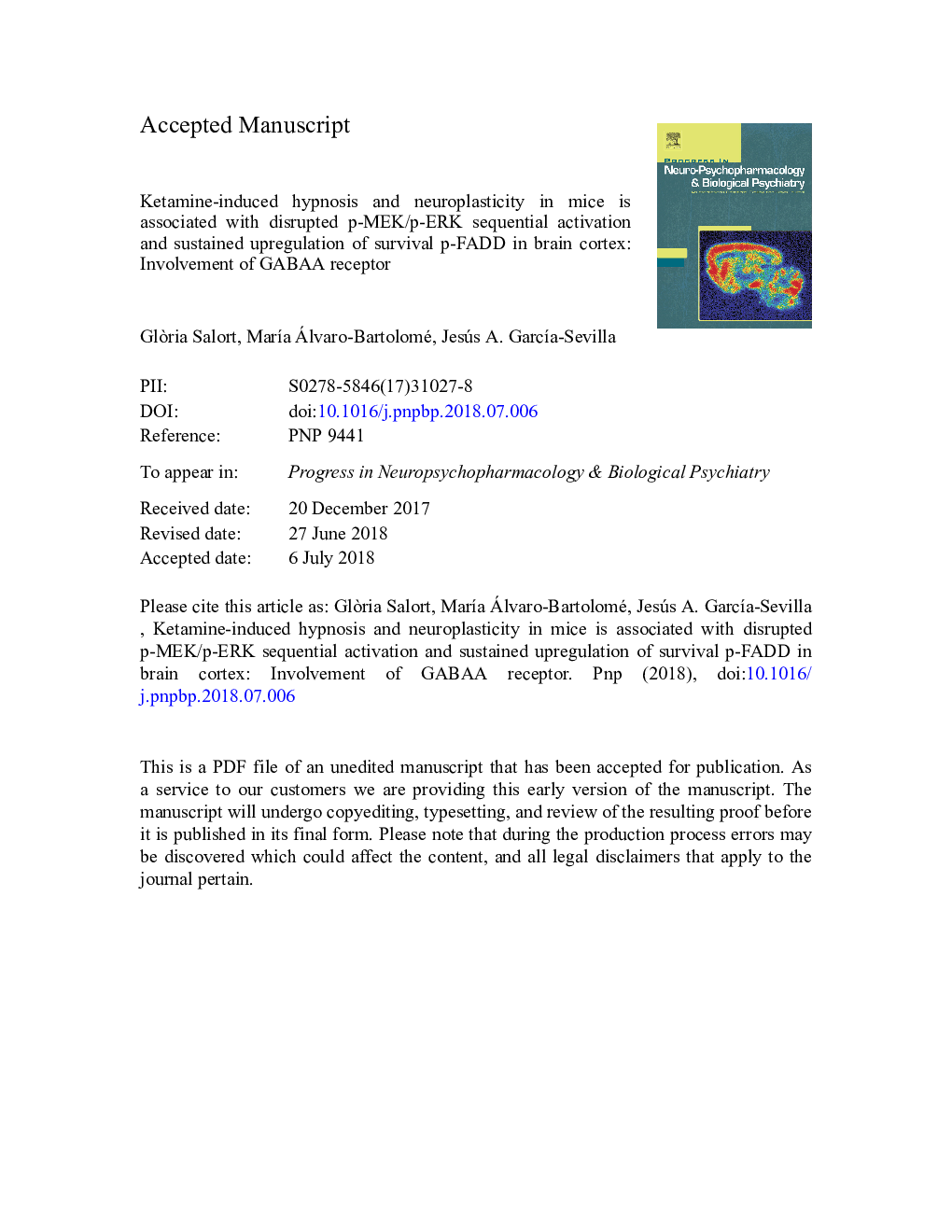| کد مقاله | کد نشریه | سال انتشار | مقاله انگلیسی | نسخه تمام متن |
|---|---|---|---|---|
| 8537134 | 1561006 | 2019 | 46 صفحه PDF | دانلود رایگان |
عنوان انگلیسی مقاله ISI
Ketamine-induced hypnosis and neuroplasticity in mice is associated with disrupted p-MEK/p-ERK sequential activation and sustained upregulation of survival p-FADD in brain cortex: Involvement of GABAA receptor
دانلود مقاله + سفارش ترجمه
دانلود مقاله ISI انگلیسی
رایگان برای ایرانیان
کلمات کلیدی
MDZMKPNF-kBERKLORRMEK-ERKloss of the righting reflexPSD-95KETNF-κBFADDMAPK - MAPKMAPK phosphatase - MAPK فسفاتازMAPK kinase - MAPK کینازγ-aminobutyric acid-A receptor - γ-آمینوآبتیریک اسید-گیرندهElk-1 - الک-1CNS - دستگاه عصبی مرکزیRighting reflex - رفلکس راستcentral nervous system - سیستم عصبی مرکزیNuclear factor-kappa B - فاکتور هسته ای-کاپا BMEK - مجاهدین خلقMouse brain - مغز ماوسMidazolam - میدازولامneurofilament light - نور نورفیلمNeuroplasticity - نوروپلاستیHypnosis - هیپنوتیزمFas-associated protein with death domain - پروتئین مرتبط با Fas با دامنه مرگmitogen-activated protein kinase - پروتئین کیناز فعال با mitogenKetamine - کتامینextracellular signal-regulated kinase - کیناز تنظیم شده سیگنال خارج سلولیGABAA - گابا
موضوعات مرتبط
علوم زیستی و بیوفناوری
علم عصب شناسی
روانپزشکی بیولوژیکی
پیش نمایش صفحه اول مقاله

چکیده انگلیسی
Ketamine (KET) is an antidepressant and hypnotic drug acting as an antagonist at excitatory NMDA glutamate receptors. The working hypothesis postulated that KET-induced sleep in mice results in dysregulation of mitogen-activated protein kinases (MAPK) MEK-ERK sequential phosphorylation and upregulation of survival p-FADD and other neuroplastic markers in brain. Low (5-15â¯mg/kg) and high (150â¯mg/kg) doses of KET on target proteins were assessed by Western immunoblot in mouse brain cortex. During the time course of KET (150â¯mg/kg)-induced sleep (up to 50â¯min) p-MEK was increased (up to +79%) and p-ERK decreased (up to â46%) indicating disruption of MEK to ERK signal. Subhypnotic KET (5-15â¯mg/kg) also revealed uncoupling of p-MEK (+13-81%) to p-ERK (unchanged content). KET did not alter contraregulatory MAPK mechanisms such as inactivated p-MEK1 (ERK dampening) and phosphatases MKP1/2/3 (ERK dephosphorylation). As other relevant findings, KET (5, 15 and 150â¯mg/kg) upregulated p-FADD in a dose-dependent manner, and for the hypnotic dose the effect paralleled the time course of sleep which resulted in increased p-FADD/FADD ratios. KET (150â¯mg/kg) also increased NF-κΠand PSD-95 neuroplastic markers. Flumazenil (a neutral allosteric antagonist at GABAA receptor) prolonged KET sleep and blocked p-MEK upregulation, indicating the involvement of this receptor as a negative modulator. SL-327 (a MEK inhibitor) augmented KET sleep, further indicating the relevance of reduced p-ERK1/2 in KET-induced hypnosis. These findings suggest that hypnotic and subhypnotic doses of KET inducing uncoupling of p-MEK to p-ERK signal and regulation of p-ERK (downregulation) and p-FADD (upregulation) may participate in the expression of some of its adverse effects (e.g. amnesia, dissociative effects).
ناشر
Database: Elsevier - ScienceDirect (ساینس دایرکت)
Journal: Progress in Neuro-Psychopharmacology and Biological Psychiatry - Volume 88, 10 January 2019, Pages 121-131
Journal: Progress in Neuro-Psychopharmacology and Biological Psychiatry - Volume 88, 10 January 2019, Pages 121-131
نویسندگان
Glòria Salort, MarÃa Álvaro-Bartolomé, Jesús A. GarcÃa-Sevilla,